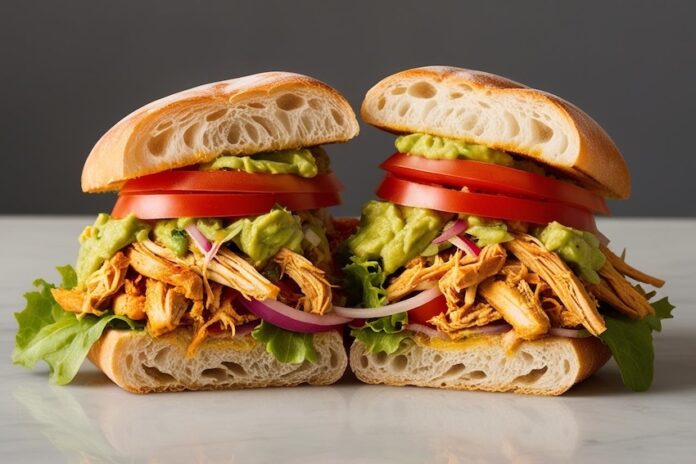Appropriately, each of Guanajuato’s three largest cities is indelibly associated with a particular specialty food item. León, the state’s largest city by population, with more than 1.7 million people, is famed as the inventor of one of the country’s most colorful and flavorful tortas. Irapuato, its second largest city with nearly 600,000 residents, is the “strawberry capital of the world,” with the jams and desserts to prove it. Celaya, the third largest city, invented cajeta, one of Mexico’s most distinctive and beloved sweets.
León and its tortas guacamayas

Mexican tortas date back to the 1890s when they were first invented in Mexico City. However, the emblematic Guanajuato version wasn’t created in León until the early 1950s at the corner of Centenario and Rio Bravo streets on the border of two neighborhoods: San Juan de Dios and San Miguel. That’s where a chicharrón vendor named Don Deme was plying his trade in 1952 when two drunk customers showed up, precipitating a series of alleged events that birthed a legend.
Somehow all the ingredients of the new sandwich were assembled — bolillo bread, chicharrón, spicy árbol chili salsa, pico de gallo, perhaps avocado and a squeeze of lime — and one of the tequila-fueled customers became so colorful in his addled ranting that his friend told him he looked like a guacamaya: Spanish for macaw. The name stuck and the sandwiches have been thusly called ever since.
Did it really happen that way? Your guess is as good as mine. But Guanajuato is one of only five states legally permitted to make tequila, so drinking it with your torta, especially if it were a state-made variety like Corralejo from Pénjamo, could be construed as an act of regional loyalty — even if you were to end up resembling a parrot by lunchtime.
But regardless of its true origins, there’s no doubt that the guacamaya is a delicious sandwich, that many other renowned vendors soon took up its cause, from Don Diego to Don Chuy, and that it retains an exalted status in the city’s culinary firmament.
Irapuato, the strawberry capital of the world

Of course, Guanajuatenses are experts at more than just the skillful blending of ingredients. They’re good at growing them, too. Guanajuato is a strong vegetable grower, producing far more broccoli, for instance, than any other state in Mexico and generating significant revenues via green chilies.
Fruits are likewise plentiful. Guanajuato is a top harvester of raspberries, blackberries, and strawberries, turning out about 20% of the country’s annual total of the latter. The center of this abundance of strawberries is Irapuato, better known as the “strawberry capital of the world,” a moniker that became associated with the city at the height of its productivity in the 1960s.
However, Irapuato’s history with strawberries began much earlier. Local politician Don Nicolás Tejada jumpstarted the local industry in 1852 when he brought 24 strawberry plants to the area from France. These were established in the Moussier area on the bank of the Guanajuato River, northeast of the city, and became the seeds of what would eventually become Irapuato’s claim to agricultural fame.

But two other 19th-century pioneers were also crucial advocates: German horticulturist Oscar Droege, who brought Old World growing techniques to the area, and Joaquín Chico González, who began shipping Irapuato’s bounty to Mexico City via railway in the 1880s, ensuring its commercial success. With their help, strawberry production in Irapuato flourished. By the 1940s, it had become the most productive growing area nationwide.
Irapuato was eventually surpassed in strawberry-growing volume, but the city remains a major producer and a focal point for those who love the luscious red fruit. Its annual celebration, the Festival de la Fresa, is traditionally held in October or November and attracts a huge turnout: the 2022 edition drew an estimated 34,000 attendees. Local tourism authorities have also established a Strawberry Route so that visitors to the area can visit the strawberry fields and even pick their own.
La Cristalita in Irapuato has been the mandatory souvenir stop since 1965. The shop stocks strawberries in every conceivable form, from fresh and frozen to marmalades, syrups, juices, candies and gift baskets with a little of everything.
Celaya and its sweet cajeta

During the colonial period, before Guanajuato became known as the birthplace of Mexican independence, it was a haven for goats. These omnivorous livestock were prized for their milk, an ingredient in myriad regional sweets dating to the 16th century.
Cajeta grew out of the Spanish sweets tradition, but the addition of goat’s milk made it a uniquely Mexican confection. Historically, it has been made in copper pots with goat milk, sugar and cinnamon or vanilla stirred with long wooden spoons until the combination achieves a caramel-like consistency.
Named for the wooden containers, called “cajetes,” in which it was displayed, the sweet treat has since become ubiquitous in Mexican cuisine. It’s used to make candies or fillings for candy, a favored flavor in popsicles and pastries, a topping that can be poured over ice cream or drizzled into coffee or hot chocolate for extra sweetness. It’s also used in countless desserts, often as a substitute for caramel.
It’s not just beloved for its sweetness, however, but for its role as a symbol of independence. After Miguel Hidalgo y Costilla uttered his famed cry of rebellion in Dolores, Guanajuato in 1810, his revolutionary army soon seized control of Celaya. According to legend, it was here that cajeta was first made and became an essential ration for soldiers.
Cajeta had much to offer for wartime use: notably, it had a long shelf life, was easy to carry and provided abundant energy. It was also delicious, which qualified it as a morale booster. In 2010, 200 years after the war began, cajeta was officially named Mexico’s “bicentennial dessert.”
Since 2018, Celaya has celebrated its famous creation annually with a Festival de la Cajeta. The most recent edition was held from Aug. 29 to Sept.1, 2024, and drew over 23,000 attendees.
Chris Sands is the Cabo San Lucas local expert for the USA Today travel website 10 Best, writer of Fodor’s Los Cabos travel guidebook and a contributor to numerous websites and publications, including Tasting Table, Marriott Bonvoy Traveler, Forbes Travel Guide, Porthole Cruise, Cabo Living and Mexico News Daily. His specialty is travel-related content and lifestyle features focused on food, wine and golf.
